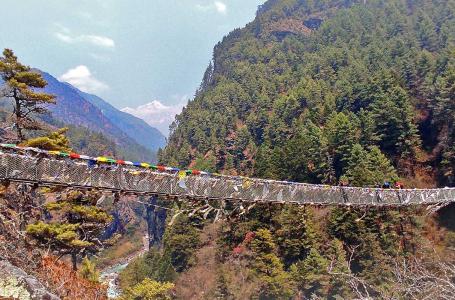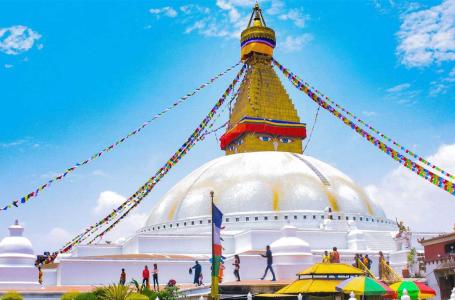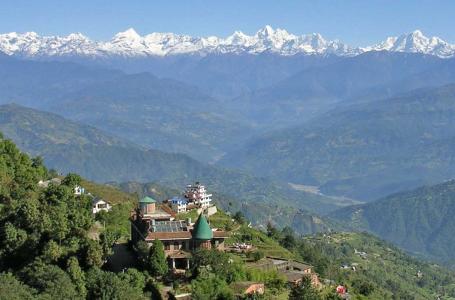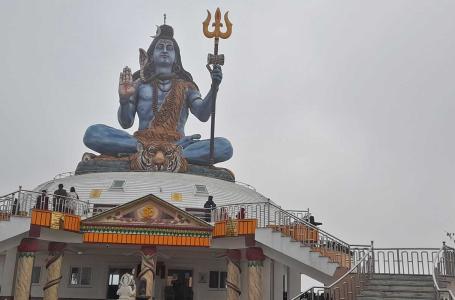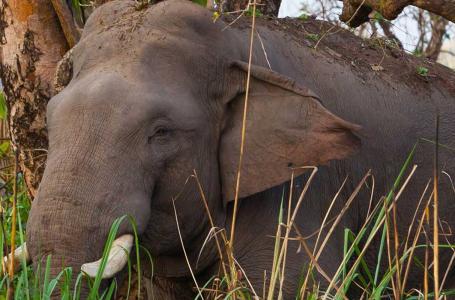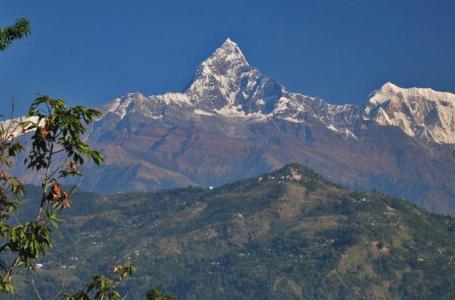Ghorepani Annapurna Base Camp Trek is a little twist in the conventional route to Annapurna Base Camp Trek.
Instead of following the direct path to the base camp, we will change the course towards Virgin Hill station of Poonhill via Ghorepani. This hill offers one of the best views of the Himalayas. When the morning sun gradually mounts over the horizon, the distinct peaks of the Dhaulagiri, Macchapuchre, and Annapurna gently turn into a golden massif. It appears so vivid and magical.
Through this natural hotspot, we will head on towards the base camp of the astounding Annapurna, just to stumble across the scenes visible from there. The base camp of the Annapurna overlooks the gorgeous panorama of mountain ranges, where the Annapurna-I dominates the northern skyline. The massive icy glaciers (unanimous), circling the mountains, create an irresistible setting around these mountains.
This Ghorepani Annapurna Base Camp Trek is a refurbished version of the customary Annapurna Base Camp trek. So, if you are looking for a new way to explore the base camp of the Annapurna, then this package might suit your interest and energy.
When planning your Ghorepani Annapurna Base Camp Trek in Nepal, it's crucial to undertake thorough research and careful itinerary planning. Start by delving into the trek's details, including its route, duration, and difficulty level. Trek itineraries typically span 7 to 14 days, depending on your fitness level and how much you wish to explore. Don't forget to acquire the required permits which can be obtained in Kathmandu or Pokhara.
Next, ensure you have appropriate trekking gear, including comfortable hiking boots, layered clothing, a sturdy backpack, a sleeping bag, and trekking poles. Decide on your preferred accommodation type, as options range from basic teahouses to camping. Additionally, bring a reusable water bottle and water purification methods for safe hydration. Food is available at the teahouse, allowing you to savor local Nepali dishes during your journey.
The spring season (March to May) offers trekkers a delightful experience with mild and pleasant weather. During this time, daytime temperatures are comfortably warm, while nights are cool. The highlight of the spring season is the vibrant rhododendron bloom, transforming the trail into a colorful tapestry of flowers.
Alternatively, autumn, from September to November, is equally enticing for trekkers. This season boasts stable weather conditions, characterized by clear skies and crisp, cool days. Visibility of the majestic mountains is at its prime, and the trails are dry and well-suited for comfortable trekking.
Trekking to Ghorepani Annapurna Base Camp is not advised during the monsoon season (June to August) due to heavy rain, slick trails, and safety hazards, or during the winter months (December to February) due to extremely cold temperatures, potential snowfall, and the closure of some facilities.
Ghorepani Annapurna Base Camp Trek food and lodgings are a mix of simplicity and needed conveniences. The majority of hotel choices along the path are teahouses or lodges run by local families. These lodges provide a variety of lodging types, ranging from communal dorms to private rooms. While the facilities are minimal, they provide warm shelter and meal options. Most rooms have common facilities, and some teahouses may offer heating, generally for a price, to counteract the cold at higher elevations.
Teahouses provide a broad menu that includes Nepali cuisine such as Dal Bhat, a filling blend of rice and lentil soup, as well as foreign selections. You'll be able to sample momo (dumplings), Tibetan bread, and other regional favorites. Vegetarian and vegan alternatives are widely available, catering to a wide range of dietary preferences and constraints. Because of the logistical problems of supply transit, costs for food and lodging may climb with altitude.
It is always advisable to consult your guide for food recommendations for a more healthy and hygienic option.
The Ghorepani Annapurna Base Camp Trek often begins at Nayapul or Phedi. If you want to fly to Pokhara, you can take a domestic airplane (30 minutes) or a tourist bus/private car to Pokhara (approximately 6-8 hours) and then go overland to Nayapul or Phedi to begin your trek. We will either remain in a hotel in Pokhara for the night or begin our adventure if we arrive early. To go to Nayapul or Phedi, we will either hire a private car (shared jeep) or use a local bus. The journey may take many hours, depending on road conditions and the starting place you select.
Trek to Ghorepani Annapurna Base Camp begins from there. The walking routes are well-marked, and you'll follow them through stunning scenery, villages, and woods until you reach the base camp.
This trip will end when you reach Siwali, where you may take a local bus back to Pokhara. If time allows, you can also opt-in for adventure activities like Paragliding in Pokhara.
Ghorepani Annapurna Base Camp requires obtaining specific permits, including the Annapurna Conservation Area Permit (ACAP) and the Trekkers' Information Management System (TIMS) card. These permits are essential for regulating trekking activities and supporting conservation efforts in the region.
1. Annapurna Conservation Area Permit (ACAP):
To visit the Annapurna area you must get an Annapurna Conservation Area Permit (ACAP). This protected area, noted for its breathtaking natural beauty, varied landscapes, and rich cultural history, is one of the most well-liked hiking areas in the nation.
Cost: Nrs 3000 per person.

2. Trekker's Information Management System(TIMS):
For hikers in Nepal, the TIMS (Trekker's Information Management System) card is a necessary piece of identification. It was put into place to improve trekkers' safety and security while also assisting authorities in keeping track of travelers in various hiking locations.
Cost: Nrs 3000 per person for non SAARC tourists and Nrs 1000 for SAARC trekkers.
(All the necessary permits are included in this package)
The journey to Pokhara by Tourist Bus can be an exciting trip as the winding highway, around the hills, will reward you with the best views of lush hills and the settlements around. The houses that are close to the highway are generally made up of modern concretes, while farther down the valley, you could see the traditional houses with thatched roofs, and stones distributed on top of them in order to protect the roof from getting swiped away by the wind.
It takes around 7 – 8 hours to arrive at Pokhara, without any stop. But, it is worth holding on at some viewpoints to catch a glimpse of the river valleys, hilly terraces, and even the mountain vistas. Once we arrive at Pokhara, we will check in to our hotel.
From Pokhara, we will drive up to Nayapul via a private Jeep. Then, a 30-minute walk from Nayapul will take us to a beautiful town named Birethanti, which is one of the prosperous towns in the Annapurna region. We will check in our permits there and then climb a short uphill to Hille. Through the village alleys, we will come out into Tikhedhunga.
The trail goes straight up from Tikhedhunga, along hundreds of meters of stone stairs, until Ulleri. This ascend is much more difficult than your expectations. However, the views of the wide river valleys, the lush hills, and snowy tops, seen from somewhere in the middle of the trek, will surely compensate for the pain of climbing.
Right after the stairs are complete, you will be welcomed by the surreal mountain views of Annapurna, Mardi, and a few other snowy legends at Ulleri. Nevertheless, these views are just the inkling of what is about to come ahead.
On the route to Ghorepani, there are no more steps to follow than in Ulleri. The trail just takes a series of ups and downs, through the dense woods of rhododendron and alpine vegetation, until arriving at the Ghorepani. In terms of altitude, it is just 800m above the Ulleri.
Most of the people, who go to Poon Hill, plan a night stay at Ghorepani just to witness the sunrise glimpse from the top of Poon Hill. You may as well add a spare day, in your itinerary, at Ghorepani to enjoy the real beauty of what Poon Hill has to offer.
Later, we will return to Ghorepani for the Overnight stay.
Before the sun wakes up in the sky, we will proceed towards the Poon Hill station to witness the stunning peaks of Machhapurchre, Dhaulagiri, Annapurna, and countless other unanimous ranges, emphasizing the beauty of the Annapurna region. It is a thrilling experience.
After an awe-inspiring sunrise view, we will return to Ghorepani, where we will recharge our bodies with a light breakfast. The first part of the trail heads on towards the Tadapani through scenic viewpoints as was seen from Poonhill. Those are the reminiscing views. The cascading waterfalls and pacing river streams, found on the way, enhance the overall setting of the trek.
From Tadapani, we will take the other trail to Chuile, skipping the one that leads to Ghandruk. It is a sharp descent for a few minutes. In the end, we will arrive at Chuile, which is quite a cold place.
For the sun to shine in Chuile, it takes a lot of time, sometimes it falls at 10 am. So, we will not have time to wait for it; therefore, once the darkness is over, we will join the trail to Sinuwa.
As we proceed, the views start to grow better and smarter with the Machhapuchre peak, showing its distinct fishtail many times on the way. We will pass through the forest that is dominated by the chirping sound of the birds. In the spring, many multi-colored butterflies spin around the lurching branches of rhododendron trees. It is so intoxicating glimpse of nature.
Once we cross Chhomrong, the trail heads on a steep way up to the Sinuwa, which is quite a village with a number of lodges distributed around it. The views of the deep river valleys of Modi Khola and Chhomrong can be seen from here.
For the first couple of hours, the trail wavers up and down through the dense forest of juniper and birch. Then, as we proceeded to Bamboo (name of the place), we could see butterflies and birds enjoying the bright sunny day. It feels so good to see them frolic in the air.
From Bamboo, we will be entering into the avalanche-prone region. Once we arrive at Dovan, we will continue towards the Deurali via the Hinku cave. There are treacherous snowfields on the way that will make you feel a little intimidated as those are the remains of the older avalanches. Without any delay, we will continue on our journey to Deurali through the alpine terrain.
There is a large overhanging rock, by the side of the trail, which used to shelter around 50 porters. This was the time when the teahouses and lodges were not invented. Until Deurali, we will walk along the snowy trail and spend a night there.
The path from Deurali winds along the off-the-beaten tracks of Annapurna for about 2 and a half hours until arriving at the base camp of the Machhapuchre. At a glance, this base camp doesn’t look like a base camp because of the lodges built around it. However, the intoxicating gusto of the Himalayas surrounds your soul here.
In order to reduce the altitude effect at Annapurna Base Camp, a night stay at a lower elevation (Machhapuchre Base Camp) is a recommended option. So, we will spend our overnight at MBC.
From Machhapurchre Base Camp, it is just a couple of hour’s morning ascent to the Annapurna Base Camp. A narrow avalanche threatened trail will guide you to the base camp of the Annapurna, where there are five built-in lodges to stay.
From the base camp, as you turn your head around, you will see the vast snowscape with mountains extruding out of the horizon. In the bright sunny day, these mountains sparkle unconditionally as if the sun woke up for them to shine. It is so majestic up there.
After spending quality time in the Annapurna Base Camp, we will descend back to a bubbly village of Bamboo through Machhapuchre Base Camp (MBC), and Deurali. The natural setting of the Bamboo is enhanced by the chirping sound of the birds and gushing sound of the rivers. It is so intoxicating.
Along the off-beaten-tracks of Annapurna, we will descend straight down to the Jhinu Danda, which is mainly famous for its natural Hot Spring. This hot spring is believed to have a natural healing capacity, so trekkers often plunge into this water spring after strenuous trekking in the Annapurna region of Nepal.
This natural hot spring has been well established by the community people; so they will charge you a little cash for a relaxing dive in the water. It is a surreal experience.
Right in the morning, we will leave Jhinu Danda towards Siwali, which is about 3 hours slog. The views and the climate, of Siwali, drastically contrast with where we came from. So, although there are not many Himalayan views, the warmth of the sun creates an extremely welcoming setting.
Once we arrive at Siwali, we will catch a local bus to Pokhara.
Trip Start and End Point
Kathmandu / Kathmandu
| DATES | STATUS | PRICE | SPACE LEFT | ||||
|---|---|---|---|---|---|---|---|
|
Start date: 02-May, 2025
End date: 11-May, 2025 |
Guaranteed | USD 995 |
2
|
Book Now | |||
|
Start date: 05-Jun, 2025
End date: 14-Jun, 2025 |
Guaranteed | USD 995 |
2
|
Book Now | |||
|
Start date: 16-Aug, 2025
End date: 25-Aug, 2025 |
Guaranteed | USD 995 |
2
|
Book Now | |||
|
Start date: 05-Sep, 2025
End date: 14-Sep, 2025 |
Guaranteed | USD 995 |
2
|
Book Now | |||
|
Start date: 14-Oct, 2025
End date: 23-Oct, 2025 |
Guaranteed | USD 995 |
3
|
Book Now | |||
|
Start date: 02-Nov, 2025
End date: 11-Nov, 2025 |
Guaranteed | USD 995 |
2
|
Book Now | |||
|
Start date: 25-Nov, 2025
End date: 04-Dec, 2025 |
Guaranteed | USD 995 |
3
|
Book Now | |||
|
Start date: 02-Dec, 2025
End date: 11-Dec, 2025 |
Guaranteed | USD 995 |
2
|
Book Now | |||
The trek typically takes 10 to 12 days, depending on the starting point, trekking pace, and acclimatization days.
The best seasons are spring (March–May) and autumn (September–November) when the weather is clear, and the views are stunning.
Yes, trekkers need two permits:
The trek is moderate in difficulty, with some steep climbs, including Ulleri's 3,000+ stone steps. Good fitness is recommended.
Yes, there are plenty of tea houses offering meals and accommodation, making it easy to trek without camping gear.

